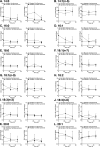Septic Shock Nonsurvivors Have Persistently Elevated Acylcarnitines Following Carnitine Supplementation
- PMID: 29384504
- PMCID: PMC5847421
- DOI: 10.1097/SHK.0000000000000997
Septic Shock Nonsurvivors Have Persistently Elevated Acylcarnitines Following Carnitine Supplementation
Abstract
Introduction: Sepsis-induced metabolic disturbances include hyperlactatemia, disruption of glycolysis, protein catabolism, and altered fatty acid metabolism. It may also lower serum L-carnitine that supports the use of L-carnitine supplementation as a treatment to ameliorate several of these metabolic consequences.
Methods: To further understand the association between L-carnitine-induced changes in serum acylcarnitines, fatty acid metabolism and survival, serum samples from (T0), 12 hfollowing completion (T24) of L-carnitine (n = 16) or placebo (n = 15) administration, and 48 h (T48) after enrollment from patients with septic shock enrolled in a randomized control trial were assayed for acylcarnitines, free fatty acids, and insulin. Data were analyzed comparing 1-year survivors and nonsurvivors within treatment groups.
Results: Mortality was 8 of 16 (50%) and 12 of 15 (80%) at 1 year for L-carnitine and placebo-treated patients, respectively. Free carnitine, C2, C3, and C8 acylcarnitines were higher among nonsurvivors at enrollment. L-Carnitine treatment increased levels of all measured acylcarnitines; an effect that was sustained for at least 36 h following completion of the infusion and was more prominent among nonsurvivors. Several fatty acids followed a similar, though less consistent pattern. Glucose, lactate, and insulin levels did not differ based on survival or treatment arm.
Conclusions: In human patients with septic shock, L-Carnitine supplementation increases a broad range of acylcarnitine concentrations that persist after cessation of infusion, demonstrating both immediate and sustained effects on the serum metabolome. Nonsurvivors demonstrate a distinct metabolic response to L-carnitine compared with survivors, which may indicate preexisting or more profound metabolic derangement that constrains any beneficial response to treatment.
Conflict of interest statement
The authors have no conflicts of interest to disclose.
Figures



Similar articles
-
Untargeted Metabolomics Differentiates l-Carnitine Treated Septic Shock 1-Year Survivors and Nonsurvivors.J Proteome Res. 2019 May 3;18(5):2004-2011. doi: 10.1021/acs.jproteome.8b00774. Epub 2019 Apr 1. J Proteome Res. 2019. PMID: 30895797 Free PMC article. Clinical Trial.
-
Pharmacometabolomics of l-carnitine treatment response phenotypes in patients with septic shock.Ann Am Thorac Soc. 2015 Jan;12(1):46-56. doi: 10.1513/AnnalsATS.201409-415OC. Ann Am Thorac Soc. 2015. PMID: 25496487 Free PMC article. Clinical Trial.
-
Preliminary safety and efficacy of L-carnitine infusion for the treatment of vasopressor-dependent septic shock: a randomized control trial.JPEN J Parenter Enteral Nutr. 2014 Aug;38(6):736-43. doi: 10.1177/0148607113495414. Epub 2013 Jul 12. JPEN J Parenter Enteral Nutr. 2014. PMID: 23851424 Free PMC article. Clinical Trial.
-
The supplementation of L-carnitine in septic shock patients: Systematic review and meta-analysis.Clinics (Sao Paulo). 2022 Oct 31;77:100124. doi: 10.1016/j.clinsp.2022.100124. eCollection 2022. Clinics (Sao Paulo). 2022. PMID: 36327640 Free PMC article.
-
L-carnitine: Searching for New Therapeutic Strategy for Sepsis Management.Curr Med Chem. 2022;29(18):3300-3323. doi: 10.2174/0929867328666211117092345. Curr Med Chem. 2022. PMID: 34789120 Review.
Cited by
-
Dichloroacetate improves systemic energy balance and feeding behavior during sepsis.JCI Insight. 2022 Jun 22;7(12):e153944. doi: 10.1172/jci.insight.153944. JCI Insight. 2022. PMID: 35730570 Free PMC article.
-
Untargeted Metabolomics Differentiates l-Carnitine Treated Septic Shock 1-Year Survivors and Nonsurvivors.J Proteome Res. 2019 May 3;18(5):2004-2011. doi: 10.1021/acs.jproteome.8b00774. Epub 2019 Apr 1. J Proteome Res. 2019. PMID: 30895797 Free PMC article. Clinical Trial.
-
Transgenerational associations between newborn metabolic profiles and bronchopulmonary dysplasia in neonates born to mothers with an obese phenotype.Sci Rep. 2025 Jan 7;15(1):1144. doi: 10.1038/s41598-025-85252-3. Sci Rep. 2025. PMID: 39774255 Free PMC article.
-
Signatures of Mitochondrial Dysfunction and Impaired Fatty Acid Metabolism in Plasma of Patients with Post-Acute Sequelae of COVID-19 (PASC).Metabolites. 2022 Oct 26;12(11):1026. doi: 10.3390/metabo12111026. Metabolites. 2022. PMID: 36355108 Free PMC article.
-
Mortality Risk Profiling of Staphylococcus aureus Bacteremia by Multi-omic Serum Analysis Reveals Early Predictive and Pathogenic Signatures.Cell. 2020 Sep 3;182(5):1311-1327.e14. doi: 10.1016/j.cell.2020.07.040. Cell. 2020. PMID: 32888495 Free PMC article.
References
-
- Takeyama N, Takagi D, Matsuo N, Kitazawa Y, Tanaka T. Altered hepatic fatty acid metabolism in endotoxicosis: effect of L-carnitine on survival. Am J Physiol. 1989;256(1 Pt 1):E31–8. - PubMed
-
- Takeyama N, Itoh Y, Kitazawa Y, Tanaka T. Altered hepatic mitochondrial fatty acid oxidation and ketogenesis in endotoxic rats. Am J Physiol. 1990;259(4 Pt 1):E498–505. - PubMed
Publication types
MeSH terms
Substances
Grants and funding
LinkOut - more resources
Full Text Sources
Other Literature Sources
Miscellaneous

